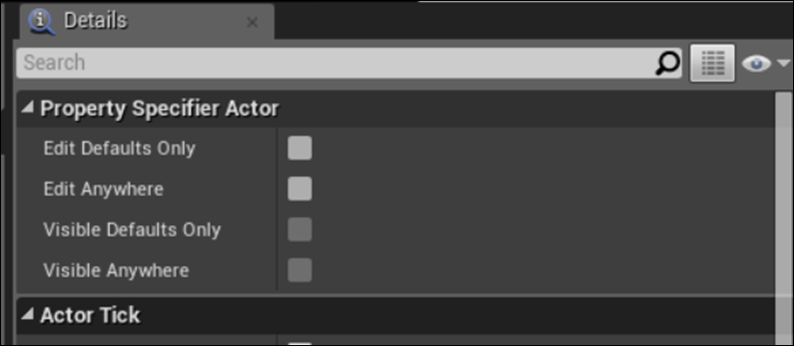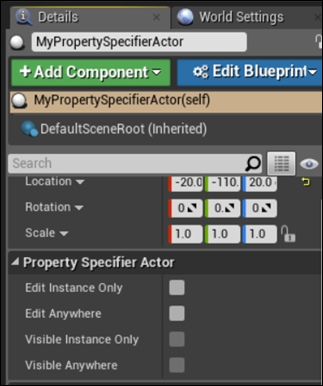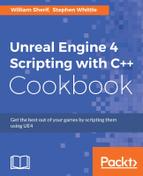When developing with Unreal, it is common for programmers to implement properties on Actors or other objects in C++, and make them visible to the editor for designer use. However, sometimes it makes sense to view a property, or to make it editable, but only on the object's default state. Sometimes the property should only be modifiable at runtime with the default specified in C++. Fortunately, there are some specifiers that can help us restrict when a property is available.
- Create a new
Actorclass in the editor calledPropertySpecifierActor. - Add the following property definitions to the class:
UPROPERTY(EditDefaultsOnly) bool EditDefaultsOnly; UPROPERTY(EditInstanceOnly) bool EditInstanceOnly; UPROPERTY(EditAnywhere) bool EditAnywhere; UPROPERTY(VisibleDefaultsOnly) bool VisibleDefaultsOnly; UPROPERTY(VisibleInstanceOnly) bool VisibleInstanceOnly; UPROPERTY(VisibleAnywhere) bool VisibleAnywhere;
- Compile your code and launch the editor.
- Create a new blueprint based on the class.
- Open the blueprint, and look at the Class Defaults section.

- Note which properties are editable and visible.

- Place instances in the level, and view their Details panels.

- Note that a different set of properties are editable.
- When specifying
UPROPERTY, we can indicate where we want that value to be available inside the Unreal editor. Visible*prefixes indicate that the value is viewable in the Details panel for the indicated object. The value won't be editable, however.- This doesn't mean that the variable is a
constqualifier; however, native code can change the value, for instance. Edit*prefixes indicate that the property can be altered within the Details panels inside the editor.InstanceOnlyas a suffix indicates that the property will only be displayed in the Details panels for instances of your class that have been placed into the game. They won't be visible in the Class Defaults section of the Blueprint editor, for example.DefaultsOnlyis the inverse ofInstanceOnly—UPROPERTYwill only display in the Class Defaults section, and can't be viewed on individual instances within the level.- The suffix
Anywhereis the combination of the two previous suffixes—theUPROPERTYwill be visible in all Details panels that inspect either the object's defaults or a particular instance in the level.
..................Content has been hidden....................
You can't read the all page of ebook, please click here login for view all page.
